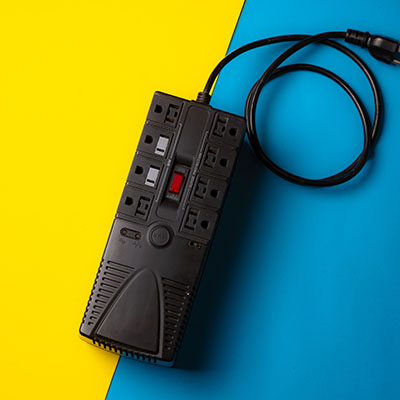Why You Need to Use a Surge Protector, Not a Power Strip

It’s easy to look at a power strip and a surge protector and question if there’s anything that actually makes them different. After all, they both give you extra plugs, right?
Yes, but there’s more to it than just that. Let’s review some of the important differences between the two that make one a far better choice for your business’ power delivery needs.
What’s So Different About Surge Protectors and Power Strips?
It’s all in the name.
A power strip does exactly what it says it does: delivers power to a strip of outlets.
So does a legitimate (more on that later) surge protector, but surge protectors also protect the devices plugged into its strip of outlets from power surges.
This Difference is Critically Important to Your Business Technology
Let’s explore a hypothetical scenario:
You have an array of important technologies—let’s assume it’s a key employee’s workstation and peripherals—plugged into one of these devices.
One day, a power surge comes into your business. If your employee was using a power strip, that surge would have essentially nothing to stop it from traveling into this team member’s devices, causing significant damage to the components of each device and quite potentially taking them out of commission. Unless you have an alternate workstation for your employee to use, they’re not going to be able to contribute much at all.
This is as expensive as it sounds—and, of course, not good. However, if your employee was using a surge protector, they’re using something designed to take the surge and reroute the excess power into the outlet’s ground. Granted, the surge protector may be damaged in the process, but replacing a surge protector is a lot less expensive than replacing a laptop or desktop. When all is said and done, this is what’s important: that you aren’t in need of a new workstation after a surge comes through.
BUYER BEWARE: Watch out for power strips labeled as surge protectors but that don’t provide the protection the name suggests. Reach out to us for help with telling the difference.
For Bigger Problems, Consider an Uninterruptible Power Supply
Keep in mind: both a power strip and a surge protector can potentially fail when exposed to too much power. As a result, your technology will suddenly receive no power. This is not good, either.
That’s why we commonly recommend that your most important devices and components—things like your servers, for instance—are protected by an uninterruptible power supply or UPS. The UPS is almost like a single-device surge protector, except that the UPS also has a built-in battery that supplies the protected device with enough power to turn it off properly.
We’re Here to Ensure Your Technology is Protected in More Ways Than One!
For assistance with protecting your business’ resources, reach out to White Mountain IT Services. Give us a call at (603) 889-0800 today!


